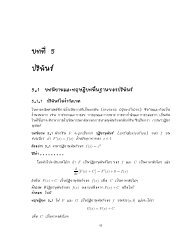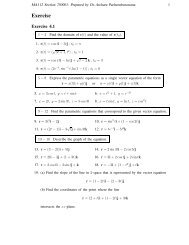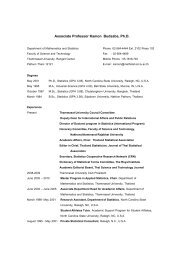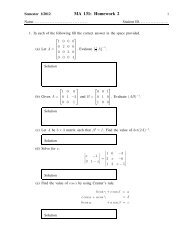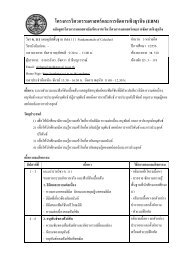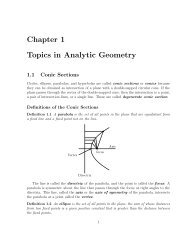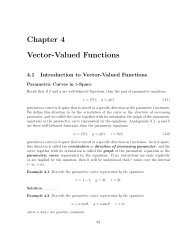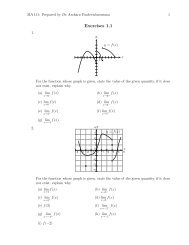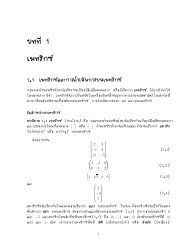Chapter 1 Topics in Analytic Geometry
Chapter 1 Topics in Analytic Geometry
Chapter 1 Topics in Analytic Geometry
Create successful ePaper yourself
Turn your PDF publications into a flip-book with our unique Google optimized e-Paper software.
MA112 Section 750001: Prepared by Dr.Archara Pacheenburawana 50Theorem 3.14(a) The l<strong>in</strong>e <strong>in</strong> 2-space that passes through the po<strong>in</strong>t P 0 (x 0 ,y 0 ) and is parallel to thenonzero vector v = 〈a,b〉 = ai+bj has parametric equationsx = x 0 +at, y = y 0 +bt (3.22)(b) The l<strong>in</strong>e <strong>in</strong> 3-space that passes through the po<strong>in</strong>t P 0 (x 0 ,y 0 ,z 0 ) and is parallel to thenonzero vector v = 〈a,b,c〉 = ai+bj+ck has parametric equationsx = x 0 +at, y = y 0 +bt, z = z 0 +ct (3.23)Example 3.27 F<strong>in</strong>d parametric equations of the l<strong>in</strong>e pass<strong>in</strong>g through the po<strong>in</strong>t (1,5,2) andparallel to the vector v = 〈4,3,7〉. Also, determ<strong>in</strong>e where the l<strong>in</strong>e <strong>in</strong>tersects the yz-plane.Solution .........Example 3.28 F<strong>in</strong>dparametricequationsof the l<strong>in</strong>eLpass<strong>in</strong>gthrough the po<strong>in</strong>tP(1,2,−1)and Q(5,−3,4).Solution .........Example 3.29 Let L 1 and L 2 be the l<strong>in</strong>es(a) Are the l<strong>in</strong>es parallel?(b) Do the l<strong>in</strong>es <strong>in</strong>tersect?Solution .........L 1 : x = 1+4t, y = 5−4t, z = −1+5tL 2 : x = 2+8s, y = 4−3s, z = 5+sTwo l<strong>in</strong>es <strong>in</strong> 3-space that are not parallel and do not <strong>in</strong>tersect are called skew l<strong>in</strong>es.L<strong>in</strong>e SegmentsSometimes one is not <strong>in</strong>terested <strong>in</strong> an entire l<strong>in</strong>e, but rather some segment of a l<strong>in</strong>e. Parametricequations of a l<strong>in</strong>e segment can be obta<strong>in</strong>ed by f<strong>in</strong>d<strong>in</strong>g parametric equation for theentire l<strong>in</strong>e, then restrict<strong>in</strong>g the parameter appropriately so that only the desired segment isgenerated.Example 3.30 F<strong>in</strong>d parametric equations describ<strong>in</strong>g the l<strong>in</strong>e segment jo<strong>in</strong><strong>in</strong>g the po<strong>in</strong>tsP(1,2,−1) and Q(5,−3,4).Solution .........



